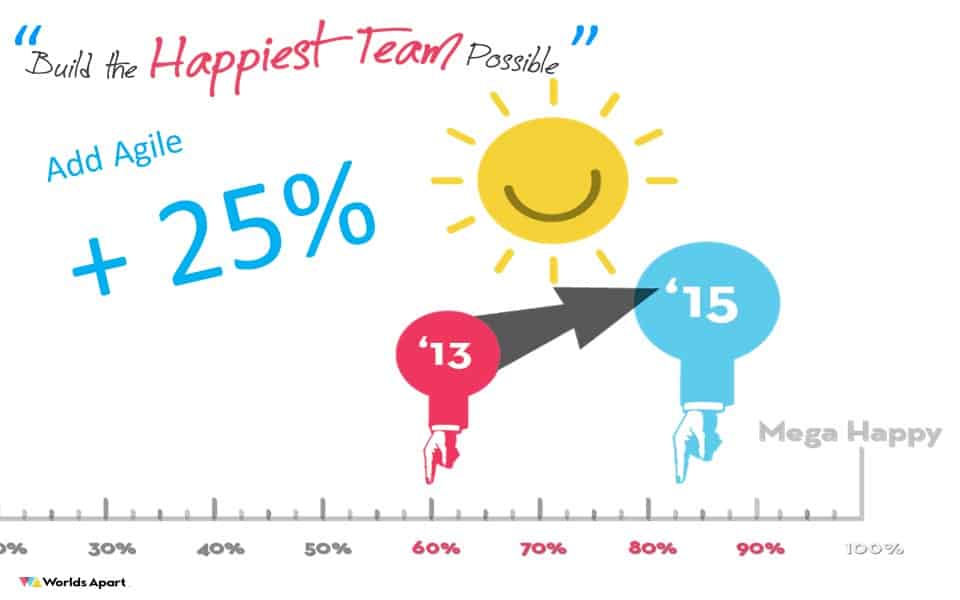User Story : As a company that’s grown really fast, we need to better understand our product development flow, so that we can improve our systems and processes.
Working with this client we mapped their flow of products through their organisation to better understand what was currently happening as products flowed through the organisation.
Each sticky note represents a product in development, from origination in R&D through Design, to Production & Shipping.
This story focuses on the Creative agility of the Design Team
As a Design Team, We need to review our workflow, So that we can improve the flow of work received from R&D through design and onto Production.
The graphic shows the third iteration of the team tracking products through the design stage. As you can see there are a lot of products in progress. (a sticky note represents a product).

There are some items in Future work
Some in To Do, the current sprint,
Some work in progress in Doing,
Nothing in Done,
and a huge number of products in ‘Paused’ which are products that are blocked from being completed.
Over the course of the first 3 iterations, work in the backlog of future work had primarily moved into ‘Paused’, no work had been completed. Each sprint more work was planned and started, but every piece of work ended up in ‘Paused’.

When the team reviewed their board at the end of the 3rd iteration. They decided they needed a bigger Paused box so they made the box bigger!
At the end of the 4th iteration I visited the team to help facilitate a retrospective and support their adoption.
Reviewing the board with the team they talked through their design of the board, the work flow over the past 4 iterations and how everything had ended up in Paused, so as part of their review they had adjusted their design to make the Paused box bigger to accommodate the volume of products held there.
This initial response from the team was a logical response, to accommodate all the items gathering in the Paused box.
A more powerful ‘being agile’ response to what the board was showing us, was to ask them the question:
Why is everything getting stuck in ‘Paused’?
The answer to this question was that each product was subject to a licencing and acceptance process with a number of large Brand partners that were featured on their product designs.
Licensing was estimated to take 2 weeks, this estimate was set when the business produced a small number of products. Now the business had grown they were sending ten times more products for licensing than previously, and it was taking far longer for the brand partners to respond to all the requests, therefore products were getting stuck in waiting while the design team waiting for their decisions. The design team were also receiving ideas from R&D to develop in large batches twice a year, so work was received in two waves meaning the back log would go from no work to a large amount of work twice a year.
To solve the problem the team worked with their brand partners to establish new estimates, and agreed to send requests in smaller batches for approval in the future. The team also worked with the R&D team to receive new products for design in smaller batches going forward too. R&D would hand over small batches as they were completed so that they could work more continuously on designing and licensing products throughout the year. They would also share early ideas that could be shared with Brand Partners to get early guidance and feedback from them on whether the ideas would be acceptable to the partners and pass the licensing process.
This is a great example of agile helping to visualise a current workflow and identify key blocks and challenges with existing processes and ways of working. By responding to what was creating the block, rather than simply creating a bigger box, the team were able to improve their flow and ways of working.

As a business grows, ways of working, processes and procedures can become ineffective as the volume of work increases. What works well at one scale, can become inefficient when scaled up. Agile helps us to identify these growing pains early and ways to adapt and improve them before they become a major challenge or issue for an organisation.
The team are also sharing their work in progress early with their Brand Partners which means that they can identify any issues earlier in the Design process when it is easier to make changes, and there is less rework required.
Contact us for a free initial conversation about how agile can help your organisation and teams
Organise a callThis story shows how a team can ‘do agile’ and visualise their work, and how they can ‘be agile’ by looking at what their board is showing them and responding to that to improve their work flow.
Doing agile – create a bigger waiting box.
Being agile – questioning and dealing with the issue that is causing the build up in waiting.
You can watch Andy’s full talk ‘Herding Creative Cats’ at Agile on the Beach here